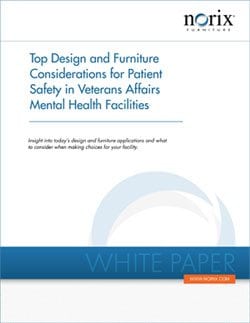White Paper: Top Design and Furniture Considerations for Patient Safety in Veterans Affairs Mental Health Facilities
 Selecting and installing furniture and fixtures and implementing design that meet the needs of a diverse veteran population can be a challenge for Department of Veterans Affairs (VA) design professionals. VA mental health facilities are unique in that they serve geriatric patients, patients with physical disabilities (such as spinal cord injuries or amputations), patients with traumatic brain injury, bariatric patients, and patients with concurrent mental/medical treatment needs.
Selecting and installing furniture and fixtures and implementing design that meet the needs of a diverse veteran population can be a challenge for Department of Veterans Affairs (VA) design professionals. VA mental health facilities are unique in that they serve geriatric patients, patients with physical disabilities (such as spinal cord injuries or amputations), patients with traumatic brain injury, bariatric patients, and patients with concurrent mental/medical treatment needs.
Healthcare furniture or equipment considered to be appropriate in a general healthcare setting may not only be unnecessary in a VA mental health unit, they may be potentially hazardous for mental health patients, staff or both. These hazards – which include suicide, injuries, violence and hygiene-related issues – are more likely to occur in mental health units located within general VA medical centers due to the mental state of those patients seeking help.
That is why the Department of Veterans Affairs recognizes the crucial role that mental health facility design plays in patient safety, welfare and recovery outcomes and how design can continue to help its ongoing efforts to transform its mental healthcare delivery system.
In our white paper, titled Top Design and Furniture Considerations for Patient Safety in Veterans Affairs Mental Health Facilities, we look to the VA’s 2010 Mental Health Facilities Design Guide for information regarding key trends in today’s mental health facilities.
 The guide is a vast and thorough document that spans more than 300 pages. Its content covers operational and design planning, information on codes and standards, recommendations on appropriate products, diagrams that illustrate proper layout of facilities and more.
The guide is a vast and thorough document that spans more than 300 pages. Its content covers operational and design planning, information on codes and standards, recommendations on appropriate products, diagrams that illustrate proper layout of facilities and more.
Additionally, we interviewed James M. Hunt, AIA, NCARB, one of the country’s foremost authorities on the design of behavioral health facilities. In the white paper, Hunt discusses in detail the following points that are applicable to behavioral healthcare design:
- Consider the product manufacturer
- Select furniture according to each particular facility
- Examine actual furniture pieces to assess durability & performance in a given location
- Evaluate actual furniture pieces to assess injury risks
- Consider the cleaning and maintenance requirements and practices
Click here to download our Top Design and Furniture Considerations for Patient Safety in Veterans Affairs Mental Health Facilities white paper.